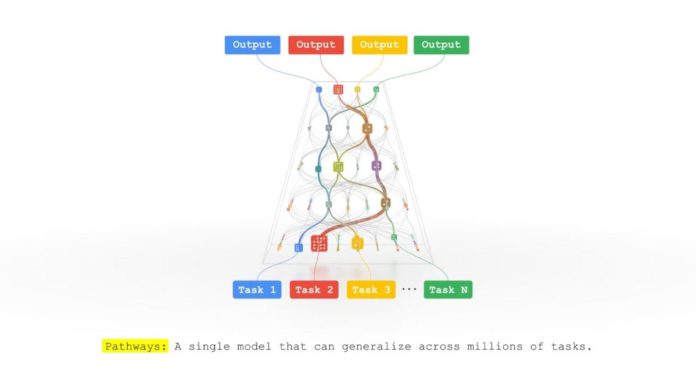Google, a subsidiary of Alphabet Inc., has unveiled Pathways, a new AI solution that combines the capabilities of many machine learning technologies into a single AI system.
According to Jeff Dean, SVP-Google Research and Health, Google Senior Fellow, and Google’s head of AI, machine learning models are overspecialized at specific tasks and rely on one form of input. Google created Pathways to synthesize them on several levels. With this technique, a single AI system will generalize over millions of jobs, grasp various sorts of data, and work more efficiently. To learn new jobs faster and more successfully, Pathways can rely on and combine its preexisting competencies. This results in an AI model that can perform a variety of tasks, similar to how humans – especially mammalian brains – function.
The solution, Jeff says, is to move away from “single-use models that just identify patterns” and towards more general intelligent systems that reflect a broader grasp of our reality and can adapt to new demands.
Artificial intelligence is already capable of forecasting flooding, detecting cancer, and rapidly translating languages, among other things. Over the last decade, advances in neural networks, combined with massive processing capacity, have allowed tech companies to construct gradually sharper AI models.
For years, Google has used artificial intelligence for various tasks, such as auto-correcting misspelled phrases and providing valuable results. Now, describing Pathways as a “next-generation AI architecture,” Google envisions it will allow us to train a single model to execute hundreds of millions of tasks. Pathways can expand an AI model’s ability to respond to input from several senses, such as text, visuals, and speech, by removing the limitations of the model’s ability to respond to information from just one ‘sense’.
The majority of today’s AI systems are trained from scratch to address every new challenge, with the model’s parameters set to random integers. As a result, organizations end up creating tens of thousands of models for tens of thousands of different activities. Each new model starts fresh to learn only one thing, rather than building on previous knowledge, making the process much more time demanding. It also takes a lot more data to learn each new work since, unlike individuals, the model tries to learn everything about the environment and the intricacies of that activity from scratch.
Read More: Google introduced new Vertex AI tools to improve ML models
To offset this issue, Pathways from Google now allows you to focus on training a single model to do several things while having different capabilities that may be combined to execute new and complicated jobs.
Meanwhile, in addition to being incredibly specialized, current artificial intelligence models focus on a single “sense,” which implies, they only process one type of information at a time. They can receive text, visuals, or speech, but only one at a time, limiting their capacity to do specific tasks and introducing biases.
Dean explains the Pathways solution can enable a transition from single-use models toward more general intelligent systems that represent a better grasp of our environment and can adapt to new demands. For instance, Google Pathways can identify a leopard if you watch, hear, read, read the word leopard, or hear a video of the animal running, or someone saying “leopard.”
The solution can enable multimodal models that include vision, auditory, and language comprehension simultaneously. It might be capable of handling more abstract data types, helping identify important patterns that have escaped human scientists in complicated systems like climate changes and more.
Overall, Dean says that Pathways offers a solution to today’s AI models’ three fundamental flaws:
– AI models are often programmed to do a single task.
– Most AI models concentrate on a single sense.
– AI models are inefficient and dense.
This is Google AI’s second solution for integrating numerous solutions to achieve a common goal. A few days ago, Google AI presented Task Affinity Groupings (TAG) that can determine which tasks in multitasking neural networks should be trained together.
For more information, visit here.


